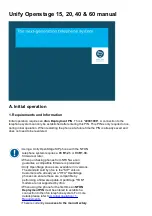
• VLAN ID
• DHCP VLAN Option
SIP and NAT Configuration
SIP and the Cisco IP Phone
The Cisco IP Phone uses Session Initiation Protocol (SIP), which allows interoperation with all IT service
providers that support SIP. SIP is an IETF-defined signaling protocol that controls voice communication
sessions in an IP network.
SIP handles signaling and session management within a packet telephony network.
Signaling
allows call
information to be carried across network boundaries.
Session management
controls the attributes of an
end-to-end call.
In typical commercial IP telephony deployments, all calls go through a SIP Proxy Server. The receiving phone
is called the SIP user agent server (UAS), while the requesting phone is called the user agent client (UAC).
SIP message routing is dynamic. If a SIP proxy receives a request from a UAS for a connection but cannot
locate the UAC, the proxy forwards the message to another SIP proxy in the network. When the UAC is
located, the response routes back to the UAS, and the two UAs connect using a direct peer-to-peer session.
Voice traffic transmits between UAs over dynamically assigned ports using Real-time Protocol (RTP).
RTP transmits real-time data such as audio and video; RTP does not guarantee real-time delivery of data. RTP
provides mechanisms for the sending and receiving applications to support streaming data. Typically, RTP
runs on top of UDP.
SIP Over TCP
To guarantee state-oriented communications, the Cisco IP Phone can use TCP as the transport protocol for
SIP. This protocol provides
guaranteed delivery
that assures that lost packets are retransmitted. TCP also
guarantees that the SIP packages are received in the same order that they were sent.
TCP overcomes the problem of UDP port-blocking by corporate firewalls. With TCP, new ports do not need
to be open or packets dropped, because TCP is already in use for basic activities, such as internet browsing
or e-commerce.
SIP Proxy Redundancy
An average SIP Proxy Server can handle tens of thousands of subscribers. A backup server allows an active
server to be temporarily switched out for maintenance. Cisco phones support the use of backup SIP Proxy
Servers to minimize or eliminate service disruption.
A static list of proxy servers is not always adequate. If your user agent serves different domains, for example,
you do not want to configure a static list of proxy servers for each domain into every Cisco IP Phone.
A simple way to support proxy redundancy is to configure a SIP Proxy Server in the Cisco IP Phone
configuration profile. The DNS SRV records instruct the phones to contact a SIP Proxy Server in a domain
named in SIP messages. The phone consults the DNS server. If configured, the DNS server returns an SRV
record that contains a list of SIP Proxy Servers for the domain, with their hostnames, priority, listening ports,
and so forth. The Cisco IP Phone tries to contact the hosts in the order of their priority.
Cisco IP Phone 6800 Series Multiplatform Phones Administration Guide
66
Phone Installation
SIP and NAT Configuration
Содержание 6800 Series
Страница 23: ...P A R T I About the Cisco IP Phone Technical Details on page 11 Cisco IP Phone Hardware on page 23 ...
Страница 24: ......
Страница 47: ...P A R T II Phone Installation Cisco IP Phone Installation on page 35 Third Party Call Control Setup on page 89 ...
Страница 48: ......
Страница 111: ...P A R T III Phone Accessories Cisco IP Phone Accessories on page 99 Wall Mount Kit on page 109 ...
Страница 112: ......
Страница 134: ......
Страница 216: ......
















































